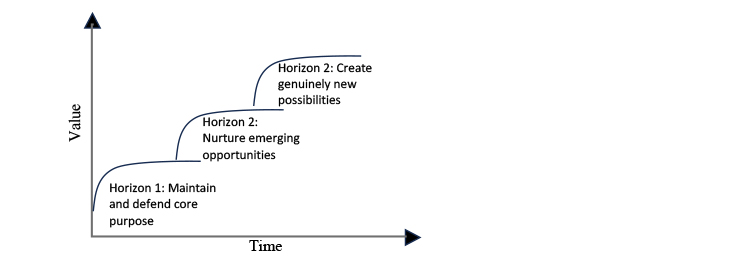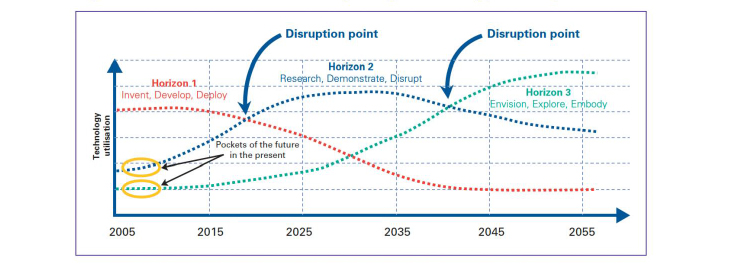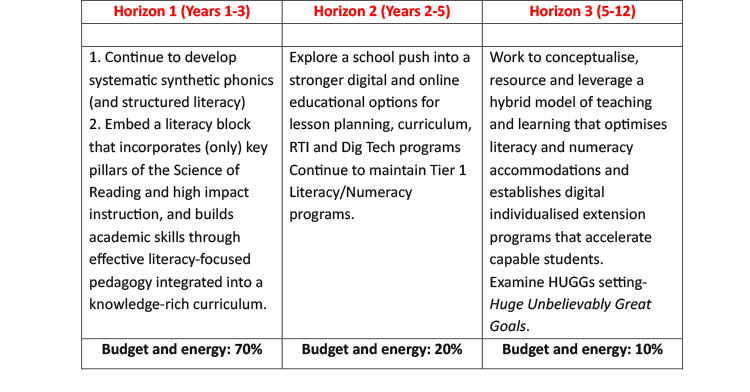The Three Horizons Model of School Planning: Looking to the Future

Often, out of necessity, most school plans focus on the short term, which is typically three years or less. This is problematic because short-term planning models have the potential to push schools into reactive modes of operation, which have a tendency to stifle creative improvement, thus killing off staff-led innovation due to change fatigue. Subsequently, these abandoned change initiatives result in sunk-cost resource wastage (Boyd, Harris & MacNeill, 2023). A far better approach to school planning and one that offers an alternative to short term modelling and goal setting may be the Three Horizons Model. Proposed by Baghai, Coley and White (2000) in The Alchemy of Growth, this useful schema aimed at business and industry, provides a promising conceptual lens for forward looking school leaders. Importantly, it can form the basis of an enriching school-community engagement program.
The Three Horizons Model of Planning
In school planning, the focus of the business plan has typically been on the year’s operations and student outcomes. Sitting over the top of the business/operational plan may be a collaboratively developed vision statement, and possibly related mission statements. Academic and trade literature on school transformation is awash with calls for schools to develop shared vision statements. Vision statements provide an aspirational view of where the school should be in the future. Silcox and MacNeill (2021) made the case for a 13-year horizon for a primary school vision to align with the length of time students from developed nations usually remain at school.
‘Developing a shared vision is a prerequisite for pedagogically focused school leader because it is the key to staff and stakeholder engagement, which aims at winning commitment, not compliance from staff.’ (p. 203).
The Three Horizons Model
The Three Horizons Model takes a conceptually appealing concept of the future as a series of distinct but overlapping stages, as can be seen in Figure 1.

Figure 1: Three horizons of change. Adapted from Baghai et al., 2000, p. 5)
Most endeavours experience a period of growth (the first curve), and over time the first curve plateaus and then falls. Charles Handy (2015, p. 23) noted that individuals and organisations recognise a problem as the first curve declines: “The nasty and often fatal snag is that the Second Curve has to start before the first curve peaks”, and the problem is always recognising that the first curve has peaked.

In contrast, in the Three Horizons Model, initiatives are seeded before the first and second curve plateau because strategy leaders are working on a three-phase model of long-term development: embryonic, emergent and mature phases of the business life-cycle (Baghai et al., 2000, p. 4). The Baghai et al. (2000) model is almost an extension of the work on the sigmoid curve originally conceived by Handy (1994, 2015), and it models a desirable growth future.
In an attempt at making an abstract model more concrete, some thinkers have attempted to assign timelines to each horizon. For example, the Board of Innovation (n.d.) posits these dates:
• Horizon 1: 1-3 years (maintain and strengthen core business)
• Horizon 2: 2-5 years (explore and discover new expansions) and
• Horizon 3: 5-12 years (create entirely new possibilities and competencies).
In Figure 2, Sharpe and Hodgson (2006) modelled future technological developments by demonstrating how the three horizons are inter-connected. In reality, the world of technology is no more volatile than the world of schooling, so this visualisation is equally applicable to the education field.

Figure 2: Three horizons in anticipating technology developments
Of real interest to school business leaders is Wright’s (2023) 70- 20- 10 rule, which sets out the percentages of the budget ideally allocated to each of the three horizons. This model is a useful rule-of-thumb for forward-looking schools. The first 70% of the budget is allocated to running the school and continuing planned programs. The second 20% is quarantined for new and emerging aspects of the school’s operations, and the final 10% is allocated to developing new capabilities and programs that will be necessary to cater for the changes that will emerge in the next 5-10 years. Projected innovations in the use of AI are a real-time example of a third horizon initiative requiring resourcing and staff training in the seed stage. This approach requires school leaders to be aware of, and address, nascent and emerging educational, political and societal trends and flashpoints.
The Three Horizons Model of Planning in a School Setting
The Three Horizons model is a brilliant strategy for schools because it promotes discussion amongst the school community about the school’s future, longer term educational opportunities for students, and the professional futures of members of staff. Sharpe et al. (2016) listed six key characteristics Three Horizons planning that are easily transferred to educational professional learning:
1 Providing a simple structure for working with complexity
2 Helping develop future consciousness (an awareness of the future potential in the present moment)
3 Helping distinguish between incremental and transformative change
4 Making explicit the processes of power and patterns of renewal
5 Enabling the exploration of how to manage transitions, and
6 Providing a framework for dialogue among actors with different mindsets.
This process delineates the drivers of change in a school setting, and the school community becomes more future aware.
To address the pervasive achievement gap in literacy that disadvantages students in our schools, Horizon 1 would focus on embedding the well-established and impactful practices identified by the science of reading, so that literacy for all students becomes the norm across the school. Horizons 2 and 3 would invest in future teaching and learning. To achieve this, the following high-level plan might be employed.

Table 1: Horizons in literacy
A Case Study in Three Horizon Thinking
The EDvance school improvement program, originally conceptualised by the philanthropic Fogarty Foundation, and now delivered by Knowledge Society, has as its bold goal the improvement of educational outcomes of students from disadvantaged communities. Schools typically begin the three-year program with aspirations to improve literacy and numeracy outcomes for their students, and to develop strategic planning and leadership skills along the way. But we are mindful of reminding schools to wear multifocal lenses to view these three horizons.
When the program began 12 years ago, most schools committed to, and were able to maintain, stability in school leadership of three years or more. We know from Louden (2015) that high performing schools often have longer serving principals and greater stability. But exhorting principals to stay the course is challenging in a context of teacher shortages; school leaders who are able to demonstrate improvements in school planning and student outcomes in the short term are often promoted out of their schools either temporarily or permanently and maintaining a meaningful school improvement trajectory is challenging.
When school communities develop high performing teaching-learning cultures that simultaneously address short, medium and long-term aspirations, new leaders working in those schools can find space for the innovation that drives them as leaders, the autonomy and agency that supports staff loyalty and meaningful collaboration, and the discipline and focus to ensure that their students experience the best possible conditions for an education that will set them up for future success.
Discussion - Does this model fit school planning, as we know it?
We have long argued the importance of ensuring that our students are advantaged as they continue into secondary schooling, and that they have acquired to mastery the skills they will require to embrace further education as a powerful tool for optimising and enriching their lives.
Exploring future trends in education with the school community is a useful exercise in bedding down a school’s vision and ensuring that both high quality educational programs and opportunities for innovation have their place. It is a great community building exercise preliminary research with school communities and then to involve them in collaboratively examining educational futures to develop a shared understanding of the school’s future direction. The HUGGs (Huge Unbelievably Great Goals) thinking may fit well here.
Secondly, school planning needs to break the press to address the immediate situations, and to look beyond the one- to three-year focus that dominates school planning. Planning for the agreed future (with community involvement) over-rides and mitigates changes that occur every time a school administration is replaced.
The challenge of the Three Horizons Model is for school leaders to be able to predict future social, political and educational trends that will impact on the school. Some potential scenarios in the current 13-year period include:
• Ongoing shortage of high performing teachers. The initial teacher education degree will simply be recognised as a ticket to practice, but schools will be increasingly discerning in relation to the skills, trainability and professional fit of all new recruits.
• Teachers’ salaries will continue to increase, and low-cost independent schools will find it increasingly difficult to stay in business.
• Digital technology and applications will be seen as a tool for planning and teaching “basic” skills, enabling teachers to leverage an infinite number of packaged teaching resources, and to design more differentiated and bespoke curricula through a hybrid teaching model.
• The Australian curriculum will fight to retain its role as an agreed standard or base-line safety net. Ambitious schools will acquire and adopt cutting-edge, world class programs so that their students can compete with students in other schools, pegged against education in high performing countries such as Singapore.
• Student well-being will become an issue as international comparisons (OECD) drive competitiveness down to the level of the individual student.
• The scope of NAPLAN testing will be widened to address the perceived narrowness of current comparisons, which are currently focussed on literacy and numeracy to the detriment of broad and deep academic curriculum.
We believe that schools need to free themselves from operational, reactive planning when they make time to articulate what they think the future will look like for their students in the third horizon, and then plan the learning programs to advantage their students in the future.
References
Baghai, M., Coley, & White, D. (2000). The Alchemy of Growth: Practical insights for building the enduring enterprise. Perseus Publishing.
Board of Innovation (n.d.). What is the 3 horizons model & how to use it. Board of Innovation. https://www.boardofinnovation.com/blog/what-is-the-3-horizons-model-how-can-you-use-it/
Boyd, R., Harris, M., & MacNeill, N. (2023, August 20). The Sunk Cost Effect impacting on school; decision making. Education Today. https://www.educationtoday.com.au/news-detail/The-Sunk-Cost-Effect-6008
Handy, C. (1994). The empty raincoat: Making sense of the future. Hutchinson.
Handy, C. (2015). The second curve: Thoughts on reinventing society. Penguin.
Louden, W. (2015). High performing primary schools: What do they have in common? Education Department of Western Australia. https://www.education.wa.edu.au/dl/kg1prm
Sharpe, B,. & Hodgson, T. (2006). Foresight intelligent infrastructure futures technology forward look. Office of Science and Technology. https://www.decisionintegrity.co.u/DIL%20Infrastructure%20Technology%20Forward%20Look%20-%20Sharpe&Hodgson.pdf
Sharpe, B., Hodgson, A., Leicester, G., Lyon, A., & Fazey, I. (2016). Three horizons: A pathways practice for transformation. Ecology and Society, 21(2), Article 47. https://www.ecologyandsociety.org/vol21/iss2/art47/
Silcox, S., & MacNeill, N. (2021). Leading school renewal. Routledge.
Wright, T. (2023). The three horizons network to help you grow. Cascade. https://www.cascade.app/blog/mckinseys-three-horizons-of-growth
Image by Jan Van Der Wolf